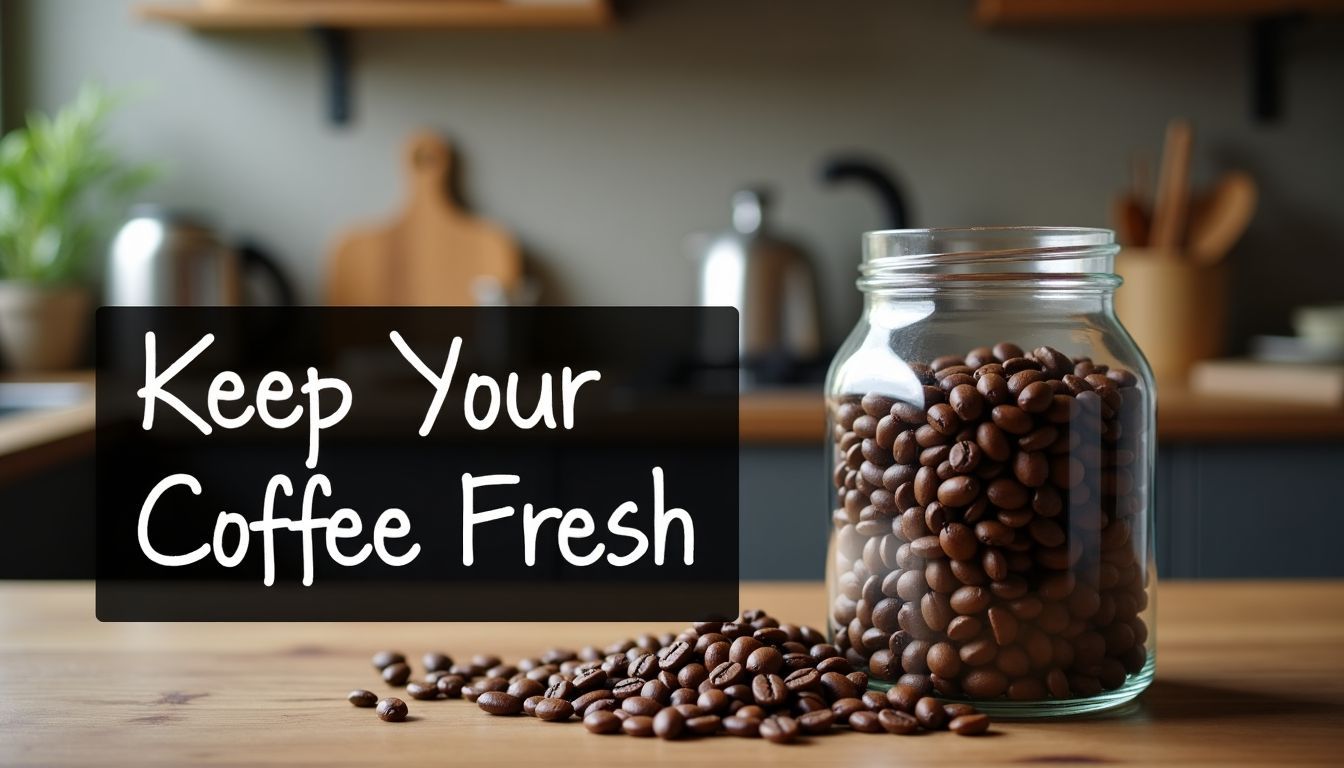How To Store Coffee Beans?
You love coffee, but your beans lose their flavour too fast. It’s frustrating to brew a cup that tastes stale or bland. You want to keep your coffee fresh and tasty for longer.
Coffee is hygroscopic – it absorbs moisture from the air. This affects its taste and aroma. Proper storage is essential to maintaining freshness. The most effective way to store coffee beans is in an airtight container, away from heat, light, and moisture.
This guide will explain how to keep your coffee beans fresh. You’ll learn about storage methods, common mistakes, and tips for preserving flavour. You’ll soon be enjoying better-tasting coffee.
What Are The Best Ways To Store Coffee Beans?
Maintaining the freshness of your coffee beans is essential for a superb brew. You can achieve this by using airtight containers, storing them in cool areas, and employing proper storage techniques.
Airtight Containers
Airtight containers preserve your coffee beans’ freshness by blocking air, light, and moisture. Quality roasters use bags with zippers and one-way valves to extend coffee freshness.
For home use, consider the Fellow Atmos Vacuum Coffee Canister, priced at £90 for a set of three. This canister features a pump to remove oxygen.
Simple alternatives are also effective. Mason jars, bottles, or sealable plastic bags are suitable if you consume your coffee within 2-4 weeks. Avoid coffee grinders with built-in storage, as they often lack proper seals.
Keep in mind that coffee is best enjoyed shortly after roasting.
Cool And Dry Place
Store your coffee beans in a cool, dry place to maintain their freshness. A pantry or cupboard away from heat sources is suitable. The best location has a consistent temperature of 20-25°C.
This helps preserve the beans’ oils and flavours. Avoid areas near ovens, stoves, or sunny windows.
A dark storage area safeguards coffee from light damage. Light can break down compounds in the beans, affecting taste. Choose an opaque container to block out light entirely. This straightforward step helps your coffee remain flavourful for 4-6 weeks after roasting.
Away From Light
Store your coffee beans in a dark place. Bright light can affect your beans’ taste. Use a dark cupboard or containers you can’t see through. The Fellow Atmos Vacuum Coffee Canister has metal exteriors that keep light out.
This helps maintain your coffee’s freshness.
When coffee beans are exposed to light, they oxidise more quickly. This process breaks down the oils responsible for coffee’s flavour. Storing them in darkness slows this down. You’ll enjoy better-tasting coffee for weeks after purchasing your beans.
Find a cool, dry area in your kitchen away from windows and artificial lighting.
Whole Beans Vs. Ground Coffee
Whole beans keep your coffee fresh longer. They stay good for about 3 months. Ground coffee loses its taste fast. It only lasts a few weeks. This happens because ground coffee touches more air.
Air makes coffee go stale quickly. You’ll get the best flavour if you grind your beans just before brewing. But if you must buy ground coffee, use it within 2 weeks for top taste.
Frozen beans can give you a better grind. The cold makes them more brittle. This helps your grinder cut them into even pieces. Even pieces mean a smoother cup of coffee. But don’t forget to put the beans in an airtight container before freezing.
This stops ice from forming on them. Ice can make your coffee taste odd.
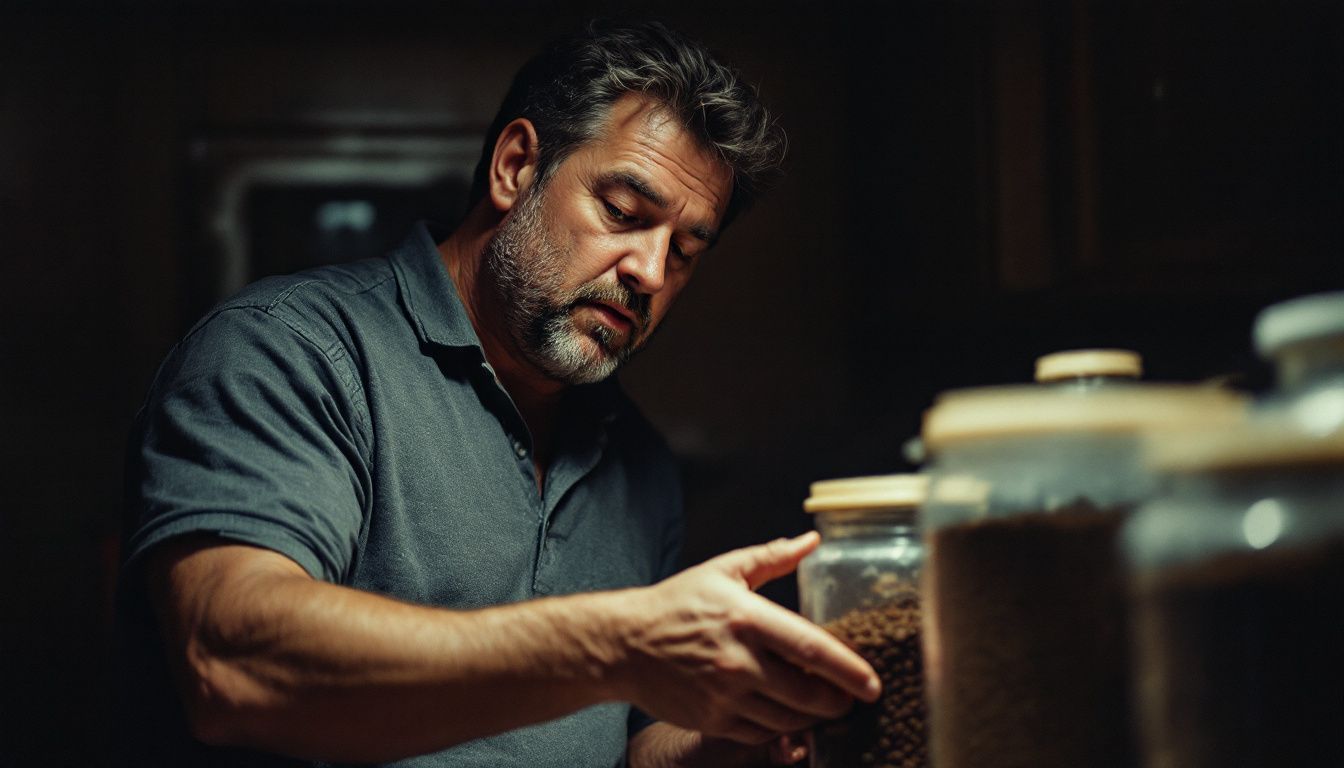
How Does Storage Affect Coffee Bean Freshness?
Storage plays a crucial role in preserving your coffee’s flavour. Improper storage can result in lacklustre taste. If you’re keen to maintain your beans’ quality, continue reading for valuable insights.
Oxidation Process
Oxidation hits your coffee hard. It’s the main reason your beans go stale. As soon as you open your coffee bag, air starts to work its magic. The oils in your beans react with oxygen, changing their taste.
This process speeds up after you grind your beans. That’s why whole beans stay fresh longer than ground coffee. Heat and light make oxidation worse. They push more oils to the surface of your beans, speeding up the staling process.
You can see and taste the effects of oxidation. Fresh beans have a rich, oily sheen. Stale beans look dry and dull. The smell changes too. Fresh coffee has a strong, pleasant aroma.
Stale coffee smells weak or odd. The taste suffers most. Oxidised coffee loses its complex flavours. It tastes flat, bitter, or rancid. To keep your coffee tasting great, fight oxidation.
Store your beans in an airtight container away from heat and light.
Moisture Impact
Moisture is your coffee’s worst enemy. It speeds up the aging process, causing your beans to lose their tasty flavours and smells. When water gets into your coffee, it makes the oils go bad faster.
This is why you must keep your beans dry. For the best taste, store your coffee in a cool, dry place away from damp areas like sinks or fridges.
Ground coffee suffers more from moisture than whole beans. The tiny bits have more surface area, so they soak up water quicker. Don’t keep ground coffee for more than a week. If you want your coffee to stay fresh longer, buy whole beans and grind them just before brewing.
This way, you’ll get the fullest flavour in every cup.
Temperature Influence
Temperature plays a significant role in preserving your coffee’s freshness. High heat accelerates the ageing process of beans. At 20°C, coffee ages most rapidly. However, at -10°C and 10°C, it maintains its quality for longer periods.
Studies indicate that coffee stored at these cooler temperatures retained its quality for 9 months. The taste remained above 7 points out of 10. Keeping your beans cool will result in better brews.
Cool storage decelerates the development of free fatty acids in coffee. These acids contribute to the deterioration of coffee’s taste over time. By storing at lower temperatures, you slow this process.
Your coffee maintains its flavour for extended periods. This allows you to purchase larger quantities without concern. You’ll consistently have fresh beans available for your morning cup.

What Are The Common Mistakes In Coffee Bean Storage?
You might be making big mistakes when storing your coffee beans. Let’s look at some common errors that can ruin your brew’s taste.
Refrigeration Issues
Putting coffee beans in the fridge is a bad idea. The cold air can make them damp, which ruins their taste. Every time you open the fridge, you let in warm air. This change in temp harms the beans.
Plus, fridges have lots of smells from other foods. Coffee beans soak up these odours like a sponge. This means your morning brew might taste like last night’s curry or cheese. To keep your beans fresh, store them in a cool, dry spot away from light.
Use an airtight tin or jar to lock in the flavour.
Freezing Concerns
Freezing coffee beans requires care. You should seal them in an airtight container before placing them in the freezer. This prevents moisture and odours from entering. After removing the beans, allow them to warm up first.
Avoid opening the bag until they reach room temperature. Opening it too soon will cause water to form on the cold beans, affecting their taste. Avoid refreezing thawed beans – it damages their flavour.
Instead, grind them while cold or leave them out overnight.
Proper freezing can preserve beans for years. Use a vacuum-sealed container for the best outcome. This approach is suitable for bulk purchases or rare blends you wish to preserve. However, for daily consumption, it’s preferable to store beans in a cool, dry area.
Regular trips to the freezer can expose beans to moisture and temperature fluctuations. This affects their oils and flavours over time.
Open Container Risks
Coffee left in open containers quickly deteriorates. Air contact spoils your beans rapidly. Oxygen degrades the oils, diminishing flavour and aroma. Light also damages coffee, particularly in transparent jars.
Your brew loses its strength within days.
For fresh coffee, use sealed, dark containers. Move beans immediately after opening the shop packet. Grind moments before brewing for the best taste. This prevents air and light damage, preserving your coffee’s rich notes.
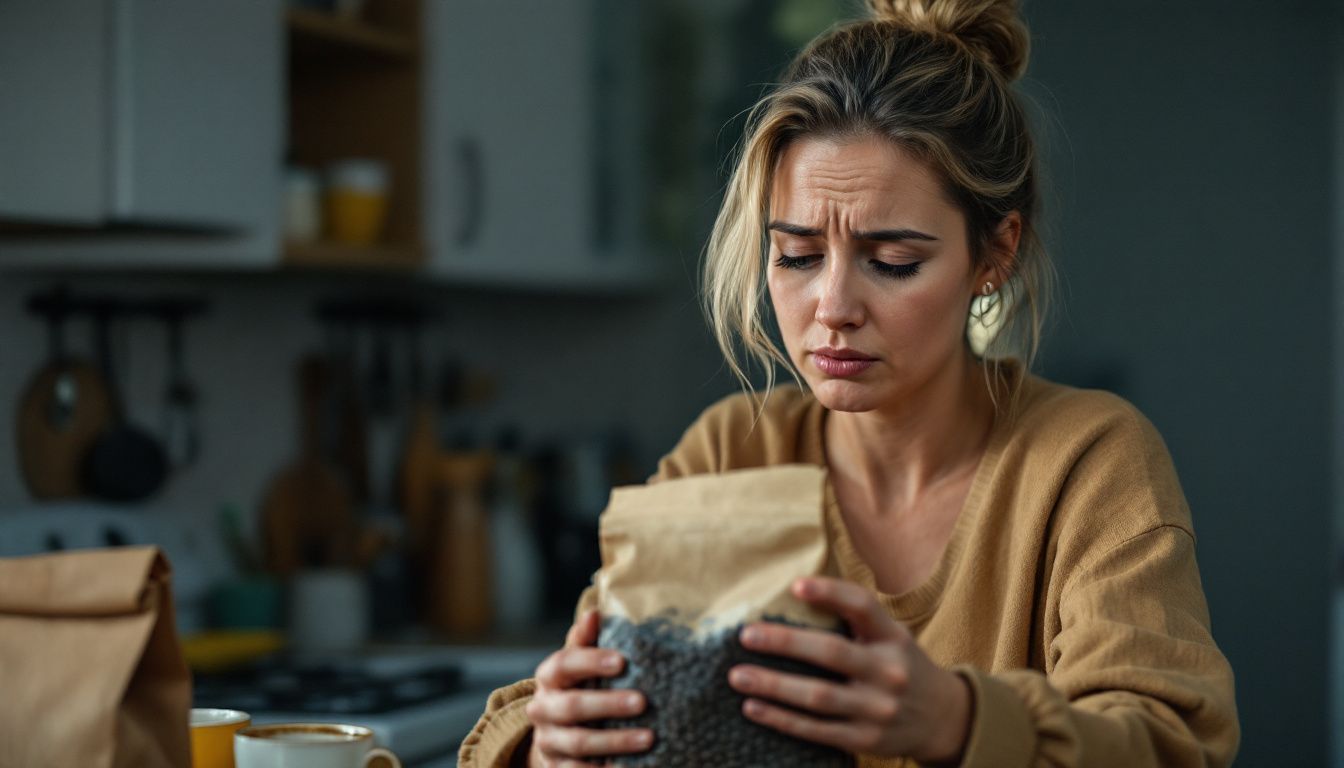
How Long Can Coffee Beans Be Stored?
Coffee beans don’t last forever. Whole beans keep fresh for about a month, while ground coffee lasts only a week or two.
Whole Bean Shelf Life
Whole coffee beans stay fresh for about 3 months after roasting. You’ll get the best taste if you use them within this time. Keep your beans in a cool, dark place to make them last.
An airtight container helps too. It stops air from getting in and affecting the flavour. Grind your beans just before brewing for the freshest cup.
Roasted beans can last up to 6 months if stored correctly. But their taste will start to fade after 3 months. Don’t keep them in the fridge or freezer. The moisture can affect the beans.
Instead, put them in a dry spot away from heat and light. This way, you’ll enjoy excellent coffee for longer.
Ground Coffee Shelf Life
Ground coffee stays fresh for about a year in unopened vacuum-sealed packs. Once you open it, use it within a week for the best taste. Oxygen and moisture are coffee’s enemies. They make it go stale fast.
Keep your ground coffee in an airtight container in a cool, dry spot. This helps it last longer and taste better.
Roasted Vs. Unroasted Beans
Roasted coffee beans offer a rich flavour but have a shorter shelf life. They stay fresh for about 3 months when stored properly. Unroasted beans, also called green coffee, last much longer – up to 2 years or more.
Green beans maintain their quality better over time, but you can’t brew them straight away. You must roast them first to bring out their taste and aroma.
The roasting process changes the beans’ chemical makeup. It creates the oils that give coffee its distinct smell and taste. Roasted beans are ready to grind and brew, while green beans need more preparation.
Your choice depends on how soon you’ll use the coffee and how much control you want over the roasting process.
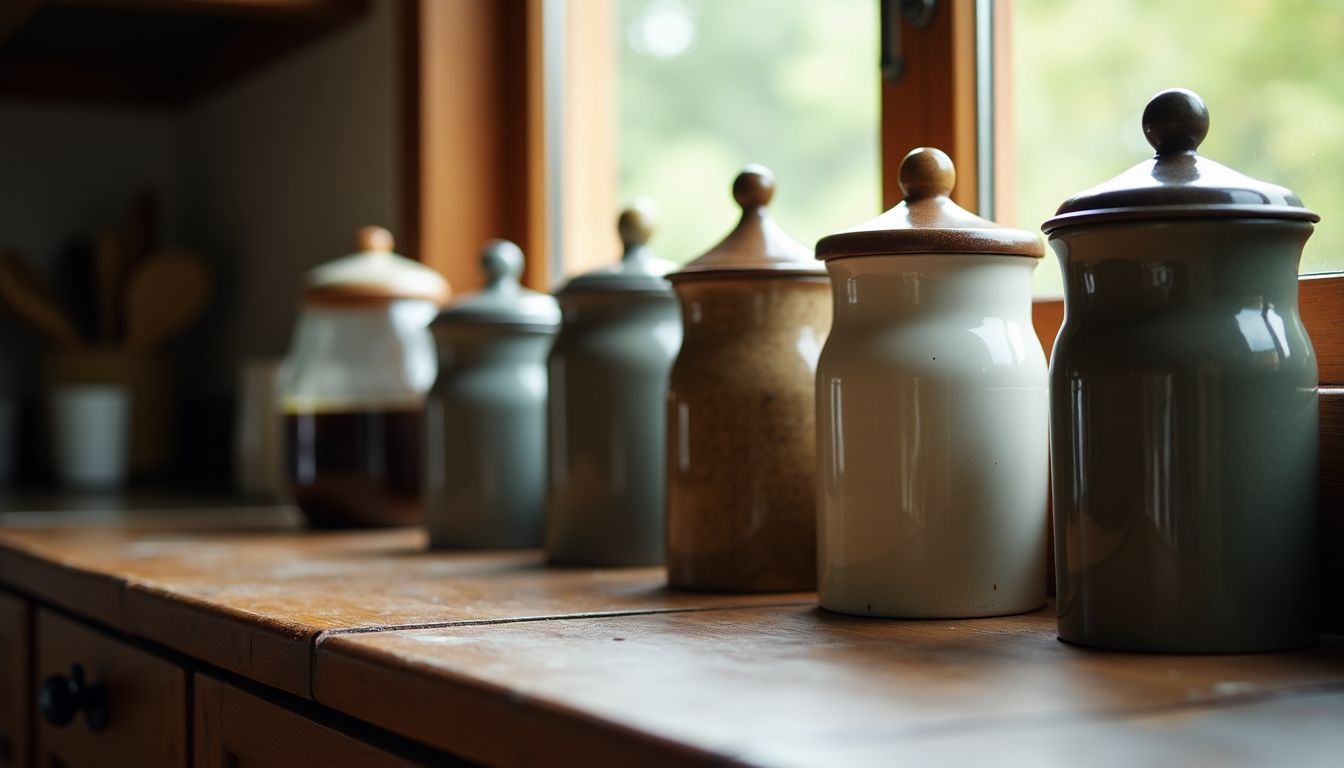
What Are The Best Containers For Coffee Bean Storage?
Various materials like ceramic, glass, steel, and specialised coffee canisters help maintain your beans’ freshness. Curious about which option might suit you best? Continue reading to find out!
Ceramic Options
Ceramic pots provide excellent storage for your coffee beans. These containers keep air and light out, which helps your beans stay fresh longer. You’ll find many styles of ceramic jars, from simple white to fancy painted ones.
They come in different sizes too, so you can pick one that fits your needs.
Ceramic is great because it doesn’t absorb smells. This means your coffee won’t pick up odd flavours from the container. Plus, these pots look nice on your kitchen counter. Just make sure to get one with a tight-fitting lid to keep the air out.
Your beans will appreciate their cosy ceramic home.
Glass Jars
Glass jars are top picks for keeping your coffee fresh. They form a tight seal, stopping air from getting in. This keeps your beans tasty for longer. Put your glass jars in a cool, dark spot.
Light and heat can make your coffee go off faster. Mason jars work well too. They’re easy to find and use. Just make sure the lid fits snugly.
Stainless Steel Containers
Stainless steel containers are top picks for keeping your coffee fresh. They block light, heat, and moisture – three big enemies of coffee flavour. You’ll find options like the Airscape canister, which comes in 250g and 500g sizes.
It’s great for home use and comes in different colours to match your kitchen.
For even better freshness, try the Fellow Atmos Vacuum Canister. It sucks out air to keep your beans at their best. These containers help your coffee stay tasty for longer. You’ll notice the difference in your daily brew when you use them.
Specialty Coffee Canisters
Specialty coffee canisters keep your beans fresh longer. Fellow Atmos Vacuum Canister tops the list at £35. It seals out air, locking in flavour. Coffee Gator’s steel canister costs £21 and has a nifty calendar wheel.
You’ll always know how old your beans are. Le Creuset’s option is pricier at £66 but less effective. Choose wisely to enjoy your coffee at its best.
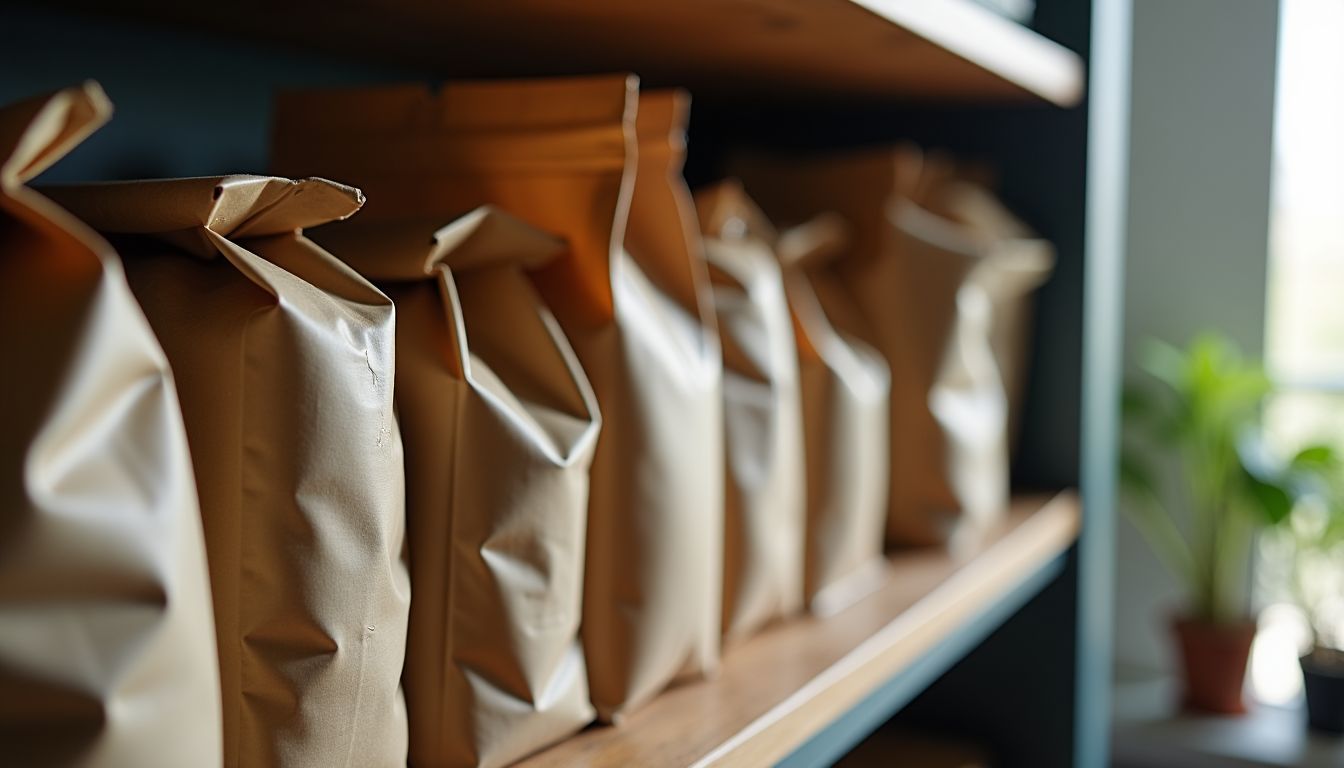
Should Coffee Beans Be Stored In The Original Packaging?
Regular coffee bags maintain freshness for a short while. However, they aren’t ideal for extended storage periods.
Pros And Cons
Original packaging has advantages and disadvantages for coffee storage. It maintains bean freshness for a brief period. However, it’s not ideal for extended use. The bags often allow air to enter.
This can cause your coffee to lose freshness quickly. You might consider transferring your beans to a more suitable container. This will help preserve their freshness for a longer duration.
Retail bags are suitable for immediate use. They’re simple to open and close. However, they don’t provide an effective seal after opening. Air enters and affects the flavour. For extended storage, use air-tight jars or cans.
These prevent oxygen from entering and preserve the flavour. Your coffee will maintain its taste for a longer period.
When To Transfer
Move your coffee to an airtight container as soon as you open the bag. This keeps it fresh longer. Paper bags let air in, which makes coffee go stale fast. You’ll taste the difference in your cup.
Buy small amounts of freshly roasted coffee often. Use it up quickly for the best flavour. This way, you won’t need to store large amounts for long periods. Your morning brew will always be at its peak.
Maintaining Flavor Integrity
Keep your coffee’s flavour intact by storing it properly. Use an airtight container to prevent air from entering and slow down oxidation. This helps preserve the aromatic oils in freshly roasted beans.
Place your container in a cool, dry spot away from light. These steps protect against the main threats to coffee freshness: air, heat, light, and moisture.
Avoid leaving your beans in the original bag for extended periods. Once opened, transfer them to a suitable storage vessel. Ceramic, glass, or stainless steel canisters are effective options.
They protect your coffee from harmful elements and maintain its taste purity. By following these straightforward guidelines, you’ll enjoy rich, flavourful brews for weeks after purchasing your beans.
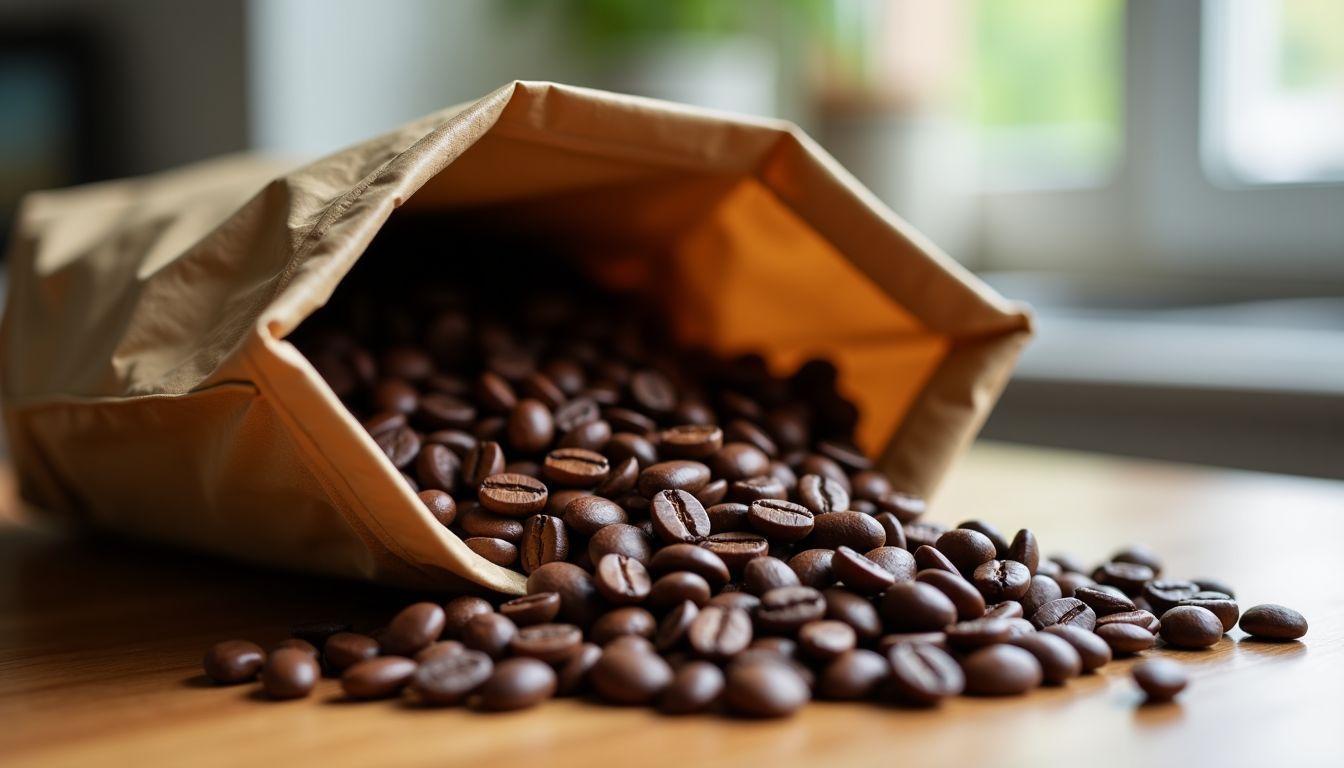
How Can You Tell If Coffee Beans Have Gone Bad?
Stale coffee beans lose their rich aroma and taste dull. You’ll notice signs like a greasy surface or mouldy smell. Want to keep your brew fresh and flavourful? Continue reading for more tips….
Visual Indicators
Fresh coffee beans have a glossy appearance. You’ll notice this sheen easily when you examine them. Older beans lack this lustre. They look dry and might even have cracks.
A sealed bag of fresh beans becomes puffy. This occurs because the beans release carbon dioxide. If you see a flat bag, it indicates the beans are stale. Look out for these signs to get the best coffee.
Aroma Changes
Coffee’s aroma evolves as it ages. Fresh beans produce a strong, pleasant scent. After 18 months, this appealing fragrance diminishes. Unpleasant odours, such as a rancid smell, begin to dominate.
You can identify old coffee by its weak or off-putting aroma. Your nose serves as an excellent indicator to determine if your coffee remains suitable for consumption.
Taste Differences
Stale coffee tastes bitter and flat. You’ll notice a big drop in flavour. Fresh beans give you a rich, complex taste. Old beans lose their subtle notes. Your cup will lack depth and aroma.
Test your coffee’s freshness by brewing a small batch. Compare it to a fresh cup from a local café. Spot the difference in taste, smell, and colour. Fresh coffee has a lively flavour and pleasant scent.
Stale coffee tastes dull and lifeless.

Conclusion
Fresh coffee tastes best. Store beans in airtight jars away from light and heat. Grind only what you need each day. Avoid the fridge – it adds moisture. Use vacuum-sealed bags for longer storage.
These steps keep your coffee rich and flavourful. You’ll enjoy a perfect cup every time. Give these methods a go and notice the difference in taste. Your mornings will be all the better for it.
FAQs
1. How do I keep my coffee beans fresh?
Store beans in a cool, dark place. Use airtight containers. Keep away from heat, light, and moisture. Avoid the fridge or freezer – they cause condensation.
2. Can I store ground coffee?
Yes, but it loses flavour fast. Best to grind just before brewing. If needed, store ground coffee like whole beans. Use vacuum-sealed bags for longer shelf life.
3. How long do coffee beans last?
Properly stored, whole beans stay fresh for 2-4 weeks. Ground coffee lasts about a week. Freshly roasted beans are best. Buy small amounts often for top quality.
4. Is it okay to keep coffee in the grinder hopper?
No, it’s not ideal. The hopper exposes beans to air. Only put in what you’ll use soon. Empty and clean the hopper regularly to avoid stale bits.
5. What’s the best container for coffee storage?
Use opaque, airtight containers. Ceramic or tinted glass work well. Some special coffee canisters have a vacuum seal. These keep beans fresh longer.
6. Should I freeze coffee for long-term storage?
It’s not recommended. Freezing can affect taste. If you must, use small, airtight bags. Remove only what you need. Let frozen beans thaw before grinding.
